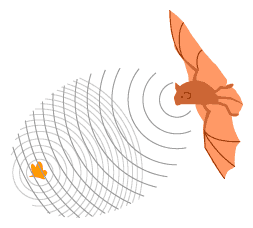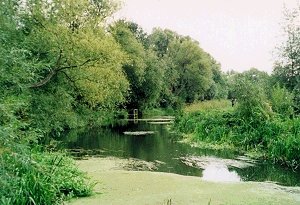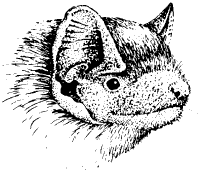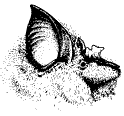introduction to bat detectors
One quarter of the world's mammal species are bats, and even in Britain
bats account for around one third of land mammal species. Most of our native
mammals are shy creatures that are difficult to observe and therefore study,
but bats are different because they fly. The trouble is they fly at night,
which is inconvenient for us, but with the advent of ultrasonic bat detectors
it is now much easier to study them.
Bat detectors are simple to use. This is a
beginner's guide to getting the most out of a bat detector and how they can be used.
what is ultrasound?
The human ear is sensitive to sound frequencies from
approximately 40 Hertz
(waves per second) to 20,000Hz (20kHz). All the noises that we are
familiar with therefore fall below 20kHz, yet there is a world of sound above this
frequency of which we are not normally aware: this is the realm of
ultrasound.
It may be a
mysterious world to humans, but many animals have hearing that is sensitive to frequencies
well above 20kHz and a few make use of such sounds. The masters of ultrasound are bats
belonging to the Sub-Order Microchiroptera.
These are the mostly small, mainly
insectivorous bats found throughout the world, with the exception of the highest latitudes
and the most remote islands. Their relatives, the flying foxes (Sub-Order
Megachiroptera)
of the Old World tropics and sub-tropics, do not, with one exception (the Egyptian Fruit
Bat, Rousettus aegyptiacus)
make use of ultrasound.
bats and ultrasonic echolocation

For centuries people have marvelled at the ability of bats to navigate confidently
in complete darkness. Whereas many nocturnal animals have large, superbly
sensitive eyes, those of most bats are rather small. How could they possibly
navigate by sight? In the 18th century
Lazarro Spallanzani, Bishop of
Padua, first blindfolded bats and then blinded them before setting them
to fly in a room strung with wires. The bats flew confidently around the
room, proving that sight was not necessary for navigation in the dark.
It was not until the late 1930s that Donald Griffin discovered that bats
produce ultrasonic calls and echolocate.
Bats generate ultrasounds in the larynx
and these are then emitted through
the mouth or nostrils. The high frequency sounds rapidly attenuate (get
quieter) as they travel, so unusually large
pinnae are used to help collect
echoes coming back from surfaces and potential prey. The echoes are analysed
in the brain to build a sound picture of the immediate surroundings. Using
this system, bats are able to navigate and hunt even in complete darkness.
Most bats "see" best at a range of between 1 and 10 metres.
Echolocation
is very costly to bats. It takes about 67 milli
Joules to
produce a pulse (the energy needed to flick a ping-pong ball half a metre
in the air). So to save energy, they synchronise the movement of their
flight and respiratory muscles.
Bats use ultrasound for echolocation because of its short wavelengths.
A strong echo will only return from an object that is at least as large
as the wavelength of the sound hitting it. So, the higher the frequency,
the more detailed the sound picture the bat can form.
ultrasonic bat detectors
Detectors convert the ultrasonic calls of bats into sounds that are clearly
audible to humans. They have been developed over the last 40 years and
the models available today are easy to use and light-weight.
Most are hand-held and basically all bat detectors have four components:
The nature of the electrical circuit depends upon the model. There are
three ways in which the ultrasonic input from bat calls can be converted
into output that is audible to humans:
1) heterodyning
The frequency to which the detector is set is subtracted from the incoming
frequency. If a bat is producing calls that peak at 55kHz and the detector
is tuned to approximately 50kHz, then an audible output of around 5kHz
will result. Tuneable detectors produce sounds with good tonal qualities
which help with species identification, but it is impossible to monitor
different frequencies simultaneously.
2) frequency division
Incoming sound waves are converted to square waves. A digital frequency
counter counts incoming waves and produces one wave for every ten (say)
counted. This has the effect of dividing the original frequency by a
factor of ten, for example, 50kHz becomes 5kHz. There are no tonal qualities
to help with identification though.
3) time expansion
The signal is stored digitally and replayed at a slower speed. This
reduces the frequency of the sound to audible levels. It is ideal for
research using computer analysis and sonograms. Time expansion models
are generally very expensive.
Bat detectors are useful tools for professional researchers and amateur
bat enthusiasts alike. Surprisingly, their greatest virtue is that they
help to make bats more visible! All bat detectors are directional and
also the nearer a bat is to the detector, the louder it sounds. So a fleeting,
shadowy silhouette against the sky becomes much easier to spot and follow
when the sparse visual cues are supplemented by these auditory ones. Detectors
can be used to measure the amount of bat activity in an area by recording
the number of bat 'passes' heard and, in suitable situations, can be used
to gain an accurate count of individual bats. This is particularly the
case if they are used as bats leave a roost, or head along a commuting
route such as a canal or hedgerow to a favourite feeding site.
With a detector it is easy to survey areas to see if there are any bats
present, although care must be exercised in drawing conclusions. Some
feeding sites will only be utilised if the weather conditions are right
or at particular times of the year. An absence of bats on one particular
night should not be regarded as conclusive evidence that they do not use
that site.
Detectors also assist in the study of behaviour. Not only do they make
it easier to see bats, but clues can be gained from their calls about
the behaviours that they are engaged in. For example, as bats close in
on aerial insect prey, the number of calls per second rapidly increase
and this produces a sound on the detector known as a 'feeding buzz'. This
makes it possible to gather data on the rate at which bats attempt to
capture prey.
studying bats
Flying bats are easy to find if you look in the right sort of places,
at the right time of year, and in reasonable weather conditions. Before
considering these aspects, the importance of safety must be emphasised.
safety
If you are planning to study bats, whether on your own, with other adults,
there are a number of safety issues to be considered. Some of these apply
to any fieldwork, but others are particularly relevant to working after
dark.
here are some basic tips:
-
Decide where you are going to work and if possible carry out reconnaissance
in daylight as well as after dark.
-
Look for hazards - e.g. water, rusting metal, barbed wire, holes
in the ground.
-
Let someone know where you are going, when, and for how long. A mobile
phone is useful and adds to your personal safety.
-
Wear good footwear. Walking boots are ideal, because you are less
likely to turn an ankle in an unseen rut.
-
Even during warm summer evenings you can get cold and miserable standing
around after dark, so make sure they are wearing several layers.
-
If you plan to be out for some time, take some food and a warm drink,
especially if you are going to be working during your normal sleeping
hours. Walking around at night uses a lot more energy than being in
bed or watching television!
-
Make sure that you have plenty of torches, spare bulbs, and batteries.
Head torches have the advantage of leaving your hands free should
you need to negotiate some obstacle.
when should you detect bats?
Bats in Britain hibernate, because there are too few aerial insects available
for them to feed on during the winter months. Exactly when they start
to hibernate and when they become fully active again depends upon the
weather. On average, hibernation lasts from the end of October to the
middle of March. Most bats will have brief periods of activity interrupting
hibernation, but the winter months are not a reliable time to find bats
on the wing.
 In
June and July the females give birth and this is a good time to study
bats. The nights are short and warm and insects are abundant. Females
are particularly busy feeding to supply their single foetus with nutrients
and then to produce milk for suckling the newborn pup. Females come together
to form maternity roosts and these can number several hundred individuals,
so roosts are most likely to be located at this time. Roosts may be in
tree holes, buildings, bridges or other structures. Bats and their roosts
are legally protected in Britain and many other countries and it is not
normally legal to enter a roost or disturb roosting bats, but there is
no problem standing outside the roost with a detector.
In
June and July the females give birth and this is a good time to study
bats. The nights are short and warm and insects are abundant. Females
are particularly busy feeding to supply their single foetus with nutrients
and then to produce milk for suckling the newborn pup. Females come together
to form maternity roosts and these can number several hundred individuals,
so roosts are most likely to be located at this time. Roosts may be in
tree holes, buildings, bridges or other structures. Bats and their roosts
are legally protected in Britain and many other countries and it is not
normally legal to enter a roost or disturb roosting bats, but there is
no problem standing outside the roost with a detector.
Bats are crepuscular in their activity, with most feeding being done
around dusk and dawn when the majority of night-flying insects are active.
These are therefore the ideal times to watch bats. The middle of the night
usually reveals less bat activity and is darker so they are harder to
see. If you can stand operating at dawn, this is when the best views are
available as many bats seem reluctant to call it a night and return to
their roost, especially when food is abundant.
Bats are most active on warm, humid, windless nights. They will tolerate
a little rain, but appear to hate really windy conditions; presumably
because it plays havoc with echolocation and flight dynamics. Bats may
be less active on moonlit nights because they are more vulnerable to predation
by owls, but the light can make it easier to observe them. Even very powerful
torches do not appear to disturb bats on the wing, and used in conjunction
with a detector, can facilitate good views.
where should you detect bats?
You are most likely to encounter flying bats in places where:
-
night-flying insects are abundant (e.g. over water);
-
suitable roost sites are nearby (mainly trees and buildings in
Britain);
-
there is some shelter from wind (e.g. trees, hedgerows).
The following are often good places for bats and likely to provide the
novice bat-watcher with a rewarding experience:
a) outside roost sites
If you know of a bat roost and the owner is amenable, they why not
wait outside to watch the bats emerge? You stand a good chance of seeing
plenty of bats and should be able to count them out because they usually
leave one at a time, although it may take a large colony an hour or
more to leave. There is also the advantage that in mid-summer most species
leave before it is properly dark so you may get a good view. Watching
bats return to a roost at dawn is even better. They often swarm around
outside the roost before entering and it may be virtually daylight before
the last bat disappears inside. Bats do not only roost in old buildings
and tree holes. The Pipistrelle bat (Pipistrellus
pipistrellus or Pipistrellus pygmaeus) is quite happy in
modern buildings sometimes moving into newly-built houses before the
owners!
b) Over bodies of water
Many species of bat take the opportunity to feed on the abundant insects
associated with water. The Daubenton's
bat (Myotis daubentonii) feeds almost exclusively over still
or gently flowing water and is easy to identify and observe. This bat
flies low and at a constant height, its wing tips almost entering the
water on the downbeat. Many of its prey are lifted off the surface of
the water by its large back feet which are employed like fishing gaffs.
It also maintains a regular flight path, making it easy to illuminate.
Canals in Britain are especially good places to watch them because they
are narrow, fairly straight, and usually have a tow-path. They are also
deep and steep sided so safety is paramount.
c) Woodlands
Broadleaf woodlands may be better bat habitats than conifer plantations
because they not only support many insects, but generally provide more
roost holes. It is best to try detecting in clearings, rides, and woodland
edges because they give bats a less cluttered flight path and are easier
for humans to walk through. Most British species will hunt in woodlands.
If conditions are windy, the middle of a wood or the sheltered side
of a wood is a good place to look for bats.
d) Illuminated areas
Bats are often attracted to lights. Research has shown however, that
bats only seek out white lights, because these are the ones that attract
insects. So look out for bat-watching opportunities where there are
tree-lined roads lit with white lights, floodlit buildings, or security
lights. Bats are also attracted to moth traps, swooping in to take insects
before they enter the trap, much to the consternation of lepidopterists!
Of course, the presence of lighting has the added bonus of making it
easier to see bats, although this advantage is countered by the fact
that your eyes do not become properly accustomed to the ambient darkness.
bat detector techniques
Despite the fact that there are only 18 species of bat found in
Britain, it is not easy to identify all of them. Some can be identified
from their call alone, but with most flying bats you have to consider
not only their call, but also their flight pattern, silhouette, behaviour,
and location to reach a satisfactory identification: what birders call
the 'jizz'.
Some species cannot be separated in flight, indeed, some are so close
(e.g. Brandt's, Myotis brandtii
and Whiskered, M. mystacinus)
that even in the hand experts have trouble agreeing! Some species are
seldom detected because they produce such quiet calls (e.g. Long-eared,
Plecotus spp., Natterer's, Myotis
nattereri), and rely more on their superb hearing to detect insects
and other arthropods sitting on vegetation, before hovering in to glean
them off leaves.
species to get started with
This is all rather discouraging, but do not despair, there are some species
that are relatively easy to identify in flight. The easiest species are:
Noctule (Nyctalus noctula)

Most people can hear some of the Noctule's relatively low frequency and
very loud call. On a detector it makes a metallic 'Chink-chink' or 'Chip-chop',
this is best at 20kHz. The Noctule bat is Britain's largest bat species,
Its early emergence, high flight, and loud, relatively low frequency calls
make it an exciting bat to detect.
They are very loud and a Noctule nearby will make the detector in the
palm of your hand feel as if someone is throwing stones at it. This is
a big, tree roosting bat that flies high and emerges before dusk. On warm
summer evenings they may be seen competing with swifts and swallows shortly
before the birds give up hunting for the night.
Daubenton's (Myotis daubentonii)

An easy bat to identify due to the way it skims across the water surface like a small hovercraft.
Daubenton's bat typically feeds just above the surface of water and produces a loud, machine-gun like
sound on a heterodyne bat detector which is loudest around 45kHz. It usually flies just above
the water, in a straight path followed by wide, repeated loops. It emerges from its roost
an hour or more after dusk.
Common Pipistrelle (Pipistrellus pipistrellus)
Soprano Pipistrelle (Pipistrellus pygmaeus)

A rich, tonal call with 'smacks' and 'plip-plop' noises. Best at 45 or
55kHz. The smallest European bat with a characteristic fluttering flight.
Frequently changes height and direction but often proves to be following
a repetitive hunting route. Britain's commonest bat and the one most likely
to be seen in suburban gardens. Interestingly, it is now two different
species, one with a call peaking at 45kHz (Common) and the other at 55kHz
(Soprano). Determining which type is present or most abundant in your
locality would make an interesting investigation. In fact we now have three Pipistrelle species in
Britain when you add in the Nathusius' Pipistrelle
(Pipistrellus nathusii) which echolocates at around 40kHz.
Greater Horseshoe (Rhinolophus ferrumequinum)
Lesser Horseshoe (Rhinolophus hipposideros)

Extremely high pitched calls of constant frequency. The 'soft' sounds
produced are quite unlike the other species and have been compared to
'warbling' sounds . Greater best at 83kHz, Lesser at 113kHz. They often
fly very low and keep close to buildings and vegetation. Both are rare
bats but we are lucky in Warwickshire to have some Lesser Horseshoe.
Detectors can be used to help find roost sites. Since a number of bats
may leave a roost at intervals over a period of many minutes, it is possible
to locate the roost by walking in the direction that bats appear to have
come from. The feeding behaviour of bats can also be usefully studied.
Detectors make it possible to identify important feeding sites by listening
for the tell-tale feeding buzzes.
There are current local and national surveys for students to get involved
in. The Bat Conservation
Trust is co-ordinating the National Bat Monitoring Programme which
aims to trial and refine field techniques to be used for the long-term
monitoring of bat populations. Detector surveying is one of the key techniques
that will be used and they welcome new volunteers.
A number of manufacturers produce bat detectors and they are now widely
available from a range of suppliers including popular internet shopping
sites. Most of the cheaper ones are of the heterodyne type. The cheapest
option is to buy a kit and construct the detector yourself, which is
fairly straightforward if you are competent with a small soldering iron.
There are quite a few books on the use of bat detectors and the analysis
of bat calls, as well as CDs and cassettes available that feature recordings
of different species of bats on a variety of detectors.